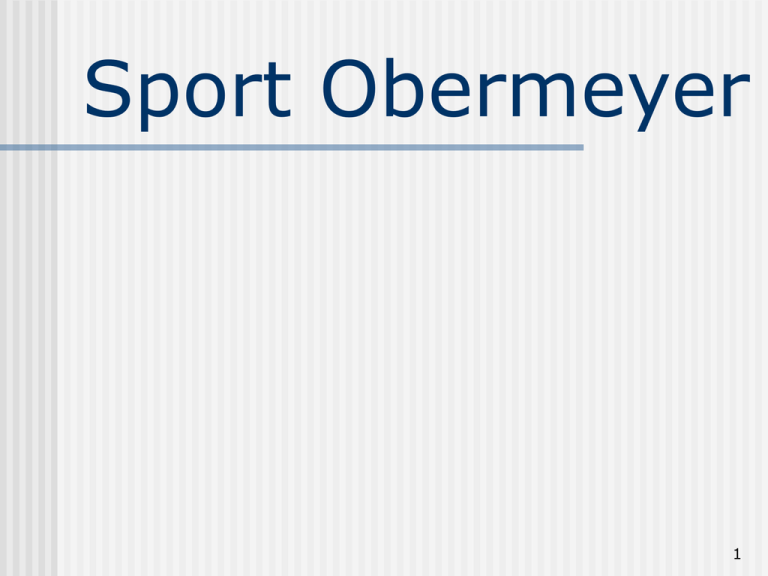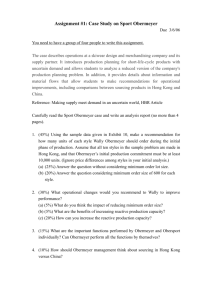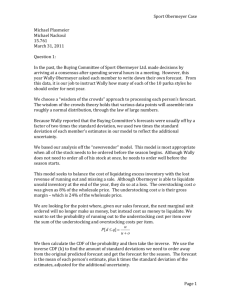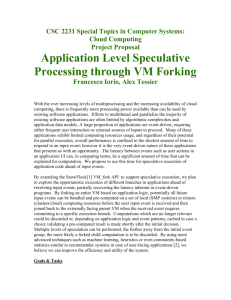Sport Obermeyer
advertisement

Sport Obermeyer
1
Sport Obermeyer’s Time Line
and
“Speculative” versus “Reactive” Production
"NOW"
Initial
Forecast
9 months
Feb
…
Oct
1992 … 1992
Design of
1993-94
Line.
Las Vegas
Revised
Forecast
5 months
Nov … Mar
1992 … 1993
5 months
April … Aug
1993 … 1993
"Speculative"
Production
"Reactive"
Production
of 1993-94 Line
of 1993-94 Line
In Feb 1993,
start design
of 1994-95
line.
“Speculative” Production
27 Months
Sept
1993
Oct
1993
Nov
1993
8 months
Dec
Jan
1993
1994
Selling of
Feb
1994
Mar
1994
Apr
1994
1993-94 Line
(peak selling in Dec & Jan)
In Feb 1994,
start design of
1995-96 line.
“Reactive” Production
2
Speculative Production:
Overstock versus Stockout?
Assume that Sport Obermeyer:
is in the Speculative Production phase,
forecasts that demand (D) for the Andy parka has a Normal Probability
Distribution with a mean of 1000 and a standard deviation of 250, and
has decided that the Andy parka’s Speculative Production should be
Q=750.
Pr{Stockout}=Pr{D>Q}
=0.841
Pr{Overstock}=Pr{D<Q}
=0.159
750
Q
During the Speculative Production, Sport Obermeyer should be more
concerned about
3
Speculative Production:
Guidelines for Choosing a Parka to Produce
In this slide and the next 4 slides, we will assume
that Sport Obermeyer is in the Speculative
Production phase and must decide whether to
produce the Andy parka or the Peter parka.
We will also assume that a parka’s demand has a
Normal Probability Distribution.
We will investigate how this decision is affected by:
the parka’s standard deviation of demand,
the parka’s mean demand, and
the parka’s unit cost of production.
4
The Effect of a Parka’s
Standard Deviation of Demand
Assume that Andy and Peter have
the same unit cost of production and
the same mean demand of 1000,
but that
Andy’s demand has a standard deviation of 100 while
Peter’s demand has a standard deviation of 200.
Pr{Overstock}=Pr{D<Q}
= Area to Left of Q
Q
During Speculative Production,
5
The Effect of a Parka’s
Mean Demand
Assume that Andy and Peter have
the same unit cost of production and
the same standard deviation for demand of 200,
but that
Andy’s demand has a mean of 1000 while
Peter’s demand has a mean of 1200.
Pr{Overstock}=Pr{D<Q}
= Area to Left of Q
Q
During Speculative Production,
6
The Effect of a Parka’s
Unit Cost of Production
Assume that Andy and Peter have
the same mean demand of 1000 and
the same standard deviation for demand of 1000,
but that
Andy’s demand has unit cost of production of $10 while
Peter’s demand has a unit cost of production of $20.
During Speculative Production,
7
Speculative Production:
Summary of Guidelines for Choosing
a Parka to Produce
In the previous 3 slides, we have seen that a parka
is a better candidate for Speculative Production if:
It has a relatively ______ standard deviation of demand.
It has relatively ______ mean demand.
It has a relatively ______ unit cost of production.
8
Speculative Production:
Equalizing over 2 Parkas
the Probability of an Overstock
Assume that Andy and Peter have
the same unit cost of production
but that
Andy’s demand has a mean of 1000 & standard deviation of 250,
Peter’s demand has a mean of 2500 & standard deviation of 500.
Q=1000 - k250
Q=2500 – k500
QUESTION: How can we set the production quantities so that
Pr{Overstock of Andy} = Pr{Overstock for Peter}? 9
Solving Wally’s Sample Problem
(on page 8 of the Case)
Using the concept on the previous slide and the sample data in
Exhibit 10, we will determine for Wally the order quantity for
each style during Speculative Production. To simply, we will
assume that:
all 10 styles in the sample problem are made in Hong
Kong,
no style has a minimum order quantity,
all styles have the same unit cost of production, and
total Speculative Production must be about 10,000 units.
10
Solving Wally’s Sample Problem
(with k=0)
DETERMINING SPECULATIVE PRODUCTION QUANTITIES
k =0
<---Find value of k that makes last column sum to about 10,000
MEAN OF
DEMAND
STYLE
Gail
Isis
Entice
Assault
Teri
Electra
Stephanie
Seduced
Anita
Daphne
Sum--->
1017
1042
1358
2525
1100
2150
1113
4017
3296
2383
20,001
STANDARD
FIRST-PERIOD
DEVIATION PRODUCTION QUANTITY
OF DEMAND
388
646
496
680
762
807
1048
1113
2094
1394
Max (0, k )
1017
1042
1358
2525
1100
2150
1113
4017
3296
2383
20,001
Too much!
Go to
Excel file.
<---Sum
11
Solving Wally’s Sample Problem
(with k=2)
DETERMINING SPECULATIVE PRODUCTION QUANTITIES
k =2
<---Find value of k that makes last column sum to about 10,000
MEAN OF
DEMAND
STYLE
Gail
Isis
Entice
Assault
Teri
Electra
Stephanie
Seduced
Anita
Daphne
Sum--->
1017
1042
1358
2525
1100
2150
1113
4017
3296
2383
20,001
STANDARD
FIRST-PERIOD
DEVIATION PRODUCTION QUANTITY
OF DEMAND
388
646
496
680
762
807
1048
1113
2094
1394
Max (0, k )
241
0
366
1165
0
536
0
1791
0
0
4,099
Too little!
<---Sum
12
Solving Wally’s Sample Problem
(with k=1)
DETERMINING SPECULATIVE PRODUCTION QUANTITIES
k =1
<---Find value of k that makes last column sum to about 10,000
MEAN OF
DEMAND
STYLE
Gail
Isis
Entice
Assault
Teri
Electra
Stephanie
Seduced
Anita
Daphne
Sum--->
1017
1042
1358
2525
1100
2150
1113
4017
3296
2383
20,001
STANDARD
FIRST-PERIOD
DEVIATION PRODUCTION QUANTITY
OF DEMAND
388
646
496
680
762
807
1048
1113
2094
1394
Max (0, k )
629
396
862
1845
338
1343
65
2904
1202
989
10,573
Too much!
<---Sum
13
Solving Wally’s Sample Problem
(with k=1.0608)
DETERMINING SPECULATIVE PRODUCTION QUANTITIES
k = 1.0608
MEAN OF
DEMAND
STYLE
Gail
Isis
Entice
Assault
Teri
Electra
Stephanie
Seduced
Anita
Daphne
Sum--->
1017
1042
1358
2525
1100
2150
1113
4017
3296
2383
20,001
<---Find value of k that makes last column sum to about 10,000
STANDARD
FIRST-PERIOD
DEVIATION PRODUCTION QUANTITY
OF DEMAND
388
646
496
680
762
807
1048
1113
2094
1394
Max (0, k )
605
357
832
1804
292
1294
1
2836
1075
904
10,000
Just right!
<---Sum
14
The Effect of
Minimum Order Quantities
Ideally, during Speculative Production, we want to
order a specific quantity of a parka style, and then,
during Reactive Production, we want to “fine tune”
the parka’s remaining supply by ordering as few or
as many as the indicated by the revised forecast
after Las Vegas.
However, a large minimum order quantity for a
particular style of parka forces us to order either
many parkas or none.
Thus, a minimum order quantity significantly
reduces the ability to “fine tune” during Reactive
Production.
15
Minimum Order Quantities
(continued)
Let “Mean” denote a parka’s mean demand.
Let “minQ” denote the parka’s minimum order quantity.
Consider the following three cases:
0
<=
Mean
Case 1
<=
minQ
<=
Mean
Case 2
<= 2minQ
<=
Mean
Case 3
During Speculative Production, which of the above three cases are
“safe” to order, and which are “risky”?
Case 1:
Case 2:
Case 3:
16
Recommendations to Wally
RECOMMENDATION #1. Improve the demand
forecasts made internally by the Buying Committee
in November just before Speculative Production.
Instead of using just a simple average of the
individual forecasts made by Laura, Carolyn, Greg,
Wendy, Tom, & Wally, use a weighted average, with
the weights reflecting past accuracy.
17
Recommendations to Wally
(continued)
RECOMMENDATION #2. Obtain market feedback
earlier than Las Vegas, thereby converting some
Speculative Production to Reactive Production.
Sport Obermeyer can invite selected retailers to
come in January to Aspen for an all-expenses-paid
“Early Order Weekend”, where there is time for
a”sneak preview” of the new line, some recreational
skiing and socializing, and then the early placement
of orders at a discount.
To maximize the value of the market feedback, Sport
Obermeyer’s “guest list” should include both large
and small retailers and both urban and resort
18
retailers.
Recommendations to Wally
(continued)
RECOMMENDATION #3. Decrease lead times for
both raw materials and finished goods, thereby
allowing more time to utilize existing capacity.
Since the business strategy should emphasize Dependability
more than Cost, lead-times can be reduced using some or all of
the following methods:
Choose suppliers of raw materials more on the basis of D
than C.
Expedite orders through information sharing with suppliers.
Expedite shipments using faster (but more expensive)
shippers.
Establish some local (but more expensive) production
capacity for “last minute” production.
19
Recommendations to Wally
(continued)
RECOMMENDATION #3 (continued).
Other ways to reduce lead times include:
From the items with long lead times, increase the amount
of “safety stock” inventory for those items that are
inexpensive (e.g., buttons) and/or shared by many parkas
(e.g., black fabric).
Simplify the parkas’ designs so that they can share as many
components as possible. For example, are 100,000
varieties of zippers really necessary?
20
Recommendations to Wally
(continued)
RECOMMENDATION #4. Increase production
capacity by:
Using more subcontractors,
Using more overtime in China, and/or
Exploring an alliance with a swimwear
manufacturer who can “supply” excess capacity
when Sport Obermeyer needs it and “consume”
capacity when Sport Obermeyer has excess
capacity.
21
Recommendations to Wally
(continued)
RECOMMENDATION #5. Decrease minimum
order quantities, thereby improving the ability to
“fine tune” during Reactive Production.
Minimum order quantities occur because there are long “set-up
times” when switching from the production of one style of
parka to another, thereby making it uneconomical to have
“short runs”.
Sport Obermeyer can decrease the minimum order quantities
by providing incentives to its suppliers to have more flexible
production lines.
This increased flexibility can come from:
Improved process design (e.g., a cellular production system).
Improved equipment (e.g., more flexible cutting machines).
22
Sport Obermeyer’s
Relationship with Obersport
In this global supply chain,
Sport Obermeyer operates in the US and specializes in the
demand side by coordinating activities such as
monitoring fashion trends,
designing the parkas, and
selling the parkas by entering into relationships with
retailers.
Obersport operates in Hong Kong and China and specializes in
the supply side by coordinating activities such as
procuring fabric and components (e.g., zippers) and
arranging for production using either independent
subcontractors or factories of Alpine (a company owned by
Obersport’s managing director).
23
Sport Obermeyer’s
Relationship with Obersport
(continued)
Global supply chains are frequently composed of different
companies, with each company having a
a different geographical location,
a different knowledge set
a different skill set, and/or
a different set of business relationships.
Sport Obermeyer should NOT eliminate its business
relationship with Obersport. Instead, it should retain its
relationship and seek to improve the coordination
between Sport Obermeyer’s demand-side activities and
Obersport’s supply-side activities.
24




